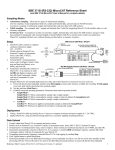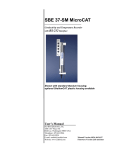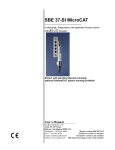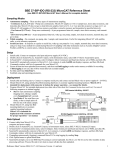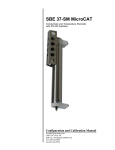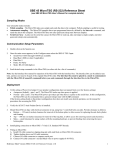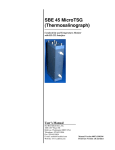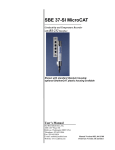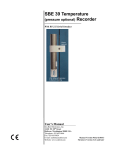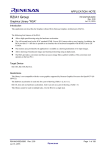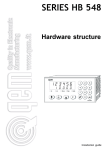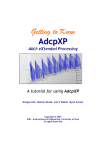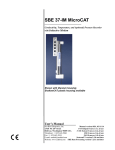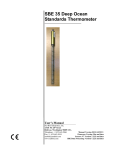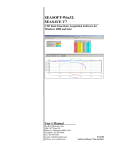Download Manual
Transcript
SBE 37-SI MicroCAT Conductivity and Temperature Monitor with RS-232 Interface User’s Manual Sea-Bird Electronics, Inc. th 1808 136 Place NE Bellevue, Washington 98005 USA Tel: 425/643-9866 Fax:425/643-9954 Manual Version #013, 02/26/02 Firmware Version 2.2 and later Limited Liability Statement Extreme care should be exercised when using or servicing this equipment. It should be used or serviced only by personnel with knowledge of and training in the use and maintenance of oceanographic electronic equipment. SEA-BIRD ELECTRONICS, INC. disclaims all product liability risks arising from the use or servicing of this system. SEA-BIRD ELECTRONICS, INC. has no way of controlling the use of this equipment or of choosing the personnel to operate it, and therefore cannot take steps to comply with laws pertaining to product liability, including laws which impose a duty to warn the user of any dangers involved in operating this equipment. Therefore, acceptance of this system by the customer shall be conclusively deemed to include a covenant by the customer to defend, indemnify, and hold SEA-BIRD ELECTRONICS, INC. harmless from all product liability claims arising from the use or servicing of this system. 2 Table of Contents Table of Contents Section 1: Introduction ................................................................................... 5 About this Manual............................................................................................. 5 How to Contact Sea-Bird .................................................................................. 5 Quick Start ........................................................................................................ 5 Unpacking the MicroCAT................................................................................. 6 Section 2: Description of the MicroCAT ....................................................... 7 System Description ........................................................................................... 7 Specifications .................................................................................................... 9 Dimensions...................................................................................................... 10 Sample Timing ................................................................................................ 11 Autonomous Sampling............................................................................. 11 Polled Sampling ....................................................................................... 11 Serial Line Sync ....................................................................................... 11 Section 3: Preparing the MicroCAT for Deployment ............................... 12 Power-Up Jumper Check................................................................................. 12 Anti-Foul Material Check ............................................................................... 13 Power and Communications Test.................................................................... 14 Test Set-Up .............................................................................................. 14 Test........................................................................................................... 15 Section 4: Deploying and Operating the MicroCAT ................................. 19 Set-Up for Deployment ................................................................................... 19 Deployment ..................................................................................................... 20 Sampling Modes.............................................................................................. 21 Polled Sampling (Sampling commands) .................................................. 21 Autonomous Sampling (Operating commands) ....................................... 22 Serial Line Synchronization (Serial Line Sync) ....................................... 23 Timeout Description........................................................................................ 24 Command Descriptions ................................................................................... 24 Data Output Formats ....................................................................................... 31 Recovery ......................................................................................................... 31 Section 5: Routine Maintenance and Calibration ..................................... 32 Corrosion Precautions ..................................................................................... 32 Conductivity Cell Maintenance....................................................................... 32 Routine Rinsing after Recovery ............................................................... 32 Cleaning ................................................................................................... 32 Sensor Calibration ........................................................................................... 34 Conductivity Sensor Calibration .............................................................. 34 Temperature Sensor Calibration............................................................... 34 Pressure Sensor (optional) Calibration..................................................... 34 Replacing Anti-Foul Cylinders ....................................................................... 35 Glossary.......................................................................................................... 36 3 Table of Contents Appendix I: Functional Description ............................................................ 37 Sensors ............................................................................................................ 37 Sensor Interface............................................................................................... 37 Appendix II: Electronics Disassembly/Reassembly.................................... 38 Disassembly .................................................................................................... 38 Reassembly...................................................................................................... 39 Appendix III: Command Summary............................................................. 40 Appendix IV: Replacement Parts ................................................................ 43 Index ............................................................................................................... 44 Warranty Policy Service Information Calibration Certificates Pressure Test Certificate Application Notes Schematics 4 Section 1: Introduction Section 1: Introduction This section includes contact information, Quick Start procedure, and photos of a standard MicroCAT shipment. About this Manual This manual is to be used with the SBE 37-SI MicroCAT Conductivity and Temperature Monitor (pressure optional). It is organized to guide the user from installation through operation and data collection. We’ve included detailed specifications, command descriptions, maintenance and calibration information, and helpful notes throughout the manual. Sea-Bird welcomes suggestions for new features and enhancements of our products and/or documentation. Please e-mail any comments or suggestions to [email protected]. How to Contact Sea-Bird Sea-Bird Electronics, Inc. 1808 136th Place Northeast Bellevue, Washington 98005 USA Telephone: Fax: E-mail: Website: 425-643-9866 425-643-9954 [email protected] http://www.seabird.com Business hours: Monday-Friday, 0800 to 1700 Pacific Standard Time (1600 to 0100 Universal Time) Except from April to October, when we are on ‘summer time’ (1500 to 0000 Universal Time) Quick Start Follow these steps to get a Quick Start using the MicroCAT. The manual provides step-by-step details for performing each task: 1. Perform pre-check procedures (see Section 3: Preparing the MicroCAT for Deployment): A. Test power and communications. B. Verify the power-up mode jumper is correctly set by observing response to QS command. 2. Deploy the MicroCAT (see Section 4: Deploying and Operating the MicroCAT): A. Set date and then time. B. Establish setup and operating parameters. C. Remove protective plugs from anti-foul cups, and verify anti-foul cylinders are installed. Leave protective plugs off for deployment. D. Install I/O cable connector and locking sleeve. E. Deploy MicroCAT, using optional Sea-Bird mounting hardware or customer-supplied hardware. 5 Section 1: Introduction Unpacking the MicroCAT Shown below is a typical MicroCAT shipment. SBE 37-SI MicroCAT User Manual I/O Cable Spare parts kit 6 Software and Software Manuals 9-pin adapter Cell cleaning solution (Triton-X) Section 2: Description of the MicroCAT Section 2: Description of the MicroCAT This section describes the functions and features of the SBE 37-SI MicroCAT, including specifications and dimensions. System Description The SBE 37-SI MicroCAT is a high-accuracy, externally powered, conductivity and temperature (pressure optional) monitor, which includes a standard serial interface. Designed to be incorporated into oceanographic sensing systems, MicroCATs have non-corroding titanium housings rated for operation to 7000 meters (23,000 feet) or pressure sensor full-scale range. Communication with the MicroCAT is over an internal, 3-wire, RS-232C link. Over 50 different commands can be sent to the MicroCAT to provide status display, data acquisition setup, data retrieval, and diagnostic tests. Userselectable operating modes include: • Autonomous sampling – There are two types of Autonomous sampling. Interval sampling: At pre-programmed intervals, the MicroCAT wakes up, samples, transmits the data, and powers off. Continuous sampling: The MicroCAT continuously samples and sends the data to the computer, and does not power off between samples. • Polled sampling – On command, the MicroCAT takes one sample and transmits the data. Polled sampling is useful for integrating the MicroCAT with satellite, radio, or wire telemetry equipment. • Serial line sync - A pulse on the serial line causes a MicroCAT to wake up, sample, transmit the data, and power off automatically. This mode provides easy integration with Acoustic Doppler Current Profilers (ADCPs) or current meters which can synchronize MicroCAT sampling with their own. Calibration coefficients stored in EEPROM allow the MicroCAT to transmit data in engineering units. The MicroCAT retains the temperature and conductivity sensors used in the SBE 16 SEACAT C-T Recorder, but has improved acquisition electronics that increase accuracy and resolution, and lower power consumption. The MicroCAT’s aged and pressure protected thermistor has a long history of exceptional accuracy and stability (typical drift is less than 0.002 °C per year). Electrical isolation of the conductivity electronics eliminates any possibility of ground-loop noise. The MicroCAT’s internal-field conductivity cell is immune to proximity errors and unaffected by external fouling. Expendable anti-fouling devices inhibit internal fouling. A plastic cup with threaded cover at each end of the cell retains the anti-foul material. The toxin quantity is typically sufficient for at least two year’s deployment. The MicroCAT's optional pressure sensor, developed by Druck, Inc., has a superior new design that is entirely different from conventional 'silicon' types in which the deflection of a metallic diaphragm is detected by epoxy-bonded silicon strain gauges. The Druck sensor employs a micro-machined silicon diaphragm into which the strain elements are implanted using semiconductor fabrication techniques. Unlike metal diaphragms, silicon's crystal structure is perfectly elastic, so the sensor is essentially free of pressure hysteresis. Compensation of the temperature influence on pressure offset and scale is performed by the SBE MicroCAT's CPU. 7 Section 2: Description of the MicroCAT Notes: • See SEATERM’s help files for detailed information on the use of the program. • Sea-Bird also supplies a DOS software package, SEASOFT-DOS, that can be used with the MicroCAT. However, this manual details only the use of the Windows software with the MicroCAT. A separate software manual on CD-ROM contains detailed information on the setup and use of SEASOFT-DOS. The MicroCAT is supplied with a Win 95/98/NT software package, SEASOFT-Win32. SEASOFT-Win32 includes SEATERM, a powerful terminal program for easy communication and data retrieval. SEATERM can send commands to the MicroCAT to provide status display, data acquisition setup, data display and capture, and diagnostic tests. Note that SEATERM does not process the data. 8 Section 2: Description of the MicroCAT Specifications Note: Pressure ranges are expressed in meters of deployment depth capability. Measurement Range Temperature (°C) Conductivity (S/m) Optional Pressure -5 to +35 0 to 7 (0 to 70 mS/cm) 0 to full scale range: 20 / 100 / 350 / 1000 / 2000 / 3500 / 7000 meters Initial Accuracy 0.002 0.0003 (0.003 mS/cm) 0.1% of full scale range Typical Stability (per month) 0.0002 0.0003 (0.003 mS/cm) 0.004% of full scale range Resolution * 0.0001 0.00001 (0.0001 mS/cm) 0.002% of full scale range +1 to +32 0 to 6; physical calibration over the range 2.6 to 6 S/m, plus zero conductivity (air) Ambient pressure to full scale range in 5 steps Sensor Calibration Counter Time-Base Quartz TCXO, ±2 ppm per year aging; ±5 ppm vs. temperature (-5 to +30 °C) Real-Time Clock Watch-crystal type 32,768 Hz; corrected for drift and aging by comparison to MicroCAT counter time-base to produce overall ± 5 ppm accuracy (±2.6 minutes/year) External Input Power 7-24 VDC Power Requirements Quiescent Current: 10 microamps Acquisition Current: 40 milliamps maximum Acquisition Time: 0.66 - 10 seconds/sample (programmable) Housing Titanium pressure case rated at 7000 meters (23,000 feet) Weight (without pressure sensor) In water: 1.9 kg (4.3 lbs) In air: 2.9 kg (6.5 lbs) *Resolution Typical RMS noise with fixed resistors on the temperature and conductivity inputs: NCYCLES Temperature (°C) Conductivity (S/m) 1 0.000220 0.000012 2 0.000173 0.000009 4 0.000127 0.000008 8 0.000094 0.000005 16 0.000060 0.000005 See Section 4: Deploying and Operating the MicroCAT for a description of NCYCLES. 9 Section 2: Description of the MicroCAT Dimensions Dimensions in millimeters (inches) Pressure port 19.0 (0.75) 139.7 (5.50) 87.6 (3.45) 67.3 (2.65) 102.9 (4.05) 108.0 (4.25) 62.2 (2.45) Diameter 27.9 (1.10) 47.5 (1.87) 241.3 (9.50) Clamp 6.63 (0.261) Diameter 4 places 436.9 (17.20) 292.1 (11.50) Guide 19.0 (0.75) 113.8 (4.48) 108.0 87.6 (3.45) (4.25) Standard Without Mounting Hardware Optional Wire Mounting Clamp and Guide Optional Flat Surface Mounting Brackets End Cap Connector The MicroCAT comes standard with a 4-pin XSG-type connector. An optional MCBH (wet-pluggable) connector is available. = standard XSG connector = optional MCBH connector 10 Section 2: Description of the MicroCAT Sample Timing Autonomous Sampling Notes: • See Section 4: Deploying and Operating the MicroCAT for a description of commands. • Autonomous Sampling is in effect when: ! Interface PCB J1 jumper is set to Normal or Autopower, and ! AUTORUN=YES and SINGLESAMPLE=NO • Polled Sampling is in effect when: ! Interface PCB J1 jumper is set to Normal or Autopower, and ! AUTORUN=NO • Serial Line Sync is in effect when: ! Interface PCB J1 jumper is set to Normal (pins 1 and 2), and ! AUTORUN=YES and SINGLESAMPLE=YES If INTERVAL < 10 (continuous sampling): • Without pressure time between samples (seconds) = (NCYCLES *0.1336) + 0.52 • With pressure time between samples (seconds) = (NCYCLES * 0.1664) + 0.75 If NCYCLES is large, the time required to sample may be more than INTERVAL. The MicroCAT will sample continuously at the rate based on NCYCLES. If INTERVAL > 10 (go to sleep between samples): • With or without pressure time between samples (seconds) = INTERVAL However, if NCYCLES is large, the time required to take a sample may be more than INTERVAL (see continuous sampling equations above). The MicroCAT will internally set the sampling rate to INTERVAL plus the actual required sampling time. Example 1: INTERVAL=8 (continuous sampling), NCYCLES=32, MicroCAT has pressure sensor. Time between samples = (32 * 0.1664) + 0.75 = 6.0748 MicroCAT will sample continuously at 6.0748-second intervals. Example 2: INTERVAL=8 (continuous sampling), NCYCLES=64, MicroCAT has pressure sensor. Time between samples = (64 * 0.1664) + 0.75 = 11.3996 MicroCAT will sample continuously at 11.3996-second intervals. Example 3: INTERVAL=11 (go to sleep between samples), NCYCLES=32, MicroCAT has pressure sensor. Time between samples = (32 * 0.1664) + 0.75 = 6.0748 < 11 MicroCAT will sample at 11-second intervals, going to sleep between samples. Example 4: INTERVAL=11 (go to sleep between samples), NCYCLES=64, MicroCAT has pressure sensor. Time between samples = (64 * 0.1664) + 0.75 = 11.3996 > 11 MicroCAT will sample at (11.3996 + 11) = 21.3996-second intervals, going to sleep between intervals. Polled Sampling Time from end of take or send sample command to beginning of reply: • Without pressure time (seconds) = (NCYCLES *0.1350) + 0.53 • With pressure time (seconds) = (NCYCLES *0.1675) + 0.84 Serial Line Sync Power-on time: • Without pressure time (seconds) = (NCYCLES *0.135) + 1.66 • With pressure time (seconds) = (NCYCLES *0.165) + 2.00 The data is sent approximately 60 milliseconds before power-off. 11 Section 3: Preparing the MicroCAT for Deployment Section 3: Preparing the MicroCAT for Deployment This section describes the pre-check procedure for preparing the MicroCAT for deployment. Checking the power-up mode jumper, checking anti-foul material, and testing power and communications are discussed. Power-Up Jumper Check The Interface Printed Circuit Board (PCB) has a jumper that controls how the MicroCAT wakes up. • Jumper set for Normal (default) - The MicroCAT powers up (wakes up) when there is a pulse on the serial interface lines. In this configuration, the MicroCAT can be controlled using the documented commands and can be commanded into a quiescent (sleep) state with the QS command. • Jumper set for Autopower - The MicroCAT wakes up when power is applied. System capability is dependent on the operating wiring configuration: ! Three wires – This configuration is useful in simple systems where a controller applies power, waits for data, and then removes power. Only three of the four wires (Power, Ground, and Transmit) are needed for operation, since it is not necessary to command the MicroCAT to take each sample. Note that the MicroCAT will not respond to any commands in this configuration, so initial setup of the system must be performed with all four wires in place (see Operating Commands in Section 4: Deploying and Operating the MicroCAT). ! Four wires - With all four wires (Power, Ground, Receive, and Transmit), the MicroCAT can receive and respond to most commands. Note that the MicroCAT will not respond to the QS command, which normally places the MicroCAT in quiescent (sleep) state. PCB labeled 10200 (Interface PCB) 1 2 Pin position on J1: • Normal (default) – pins 1 and 2 • Autopower – pins 2 and 3 3 J1 Note: See Appendix I: Electronics Disassembly/Reassembly for details on accessing the PCB. Verify the jumper setting in one of the following ways: • Remove the PCB from the housing to check the jumper setting, or • Connect the MicroCAT to the computer and enter communication parameters as described in Power and Communications Test, wake up the MicroCAT by clicking the Connect button on the Toolbar, and then enter the QS command after the S> prompt. The response indicates whether the jumper is in the Normal or Autopower configuration: ! Autopower - system returns S> prompt, indicating that the MicroCAT is not in quiescent state. ! Normal – system does not return S> prompt, indicating that the MicroCAT is in quiescent state. 12 Section 3: Preparing the MicroCAT for Deployment Anti-Foul Material Check New MicroCATs are shipped with anti-foul cylinders and protective plugs pre-installed. Verify that the cylinders are in the anti-foul cups. See Section 5: Routine Maintenance and Calibration for details on replacing the anti-foul cylinders. Anti-foul cylinder The protective plugs must be removed prior to deployment or pressurization. If the plugs are left in place during deployment, the sensor will not register conductivity. If left in place during pressurization, the cell may be destroyed. Protective plug Plug Cap Cup 13 Section 3: Preparing the MicroCAT for Deployment Power and Communications Test The power and communications test will verify that the system works, prior to deployment. Test Set-Up Note: It is possible to use the MicroCAT without SEATERM by sending direct commands from a dumb terminal or terminal emulator, such as Windows HyperTerminal. 1. If not already installed, install SEATERM and other Sea-Bird software programs on your computer using the supplied software CD: A. Insert the CD in your CD drive. B. Double click on Seasoft-Win32.exe. C. Follow the dialog box directions to install the software. The default location for the software is c:/Program Files/Sea-Bird. Within that folder is a sub-directory for each program. 2. By hand, unscrew the locking sleeve from the MicroCAT’s bulkhead connector. If you must use a wrench or pliers, be careful not to loosen the bulkhead connector instead of the locking sleeve. 3. Remove the dummy plug from the MicroCAT’s I/O bulkhead connector by pulling the plug firmly away from the connector. 4. Install the Sea-Bird I/O cable connector, aligning the raised bump on the side of the connector with the large pin (pin 1 - ground) on the MicroCAT. 5. Connect the I/O cable connector to your computer’s serial port. A 25-to-9 pin adapter is supplied for use if your computer has a 9-pin serial port. 6. Connect the I/O cable connector’s red (+) and black (-) wires to a power supply (7-24 VDC). Locking sleeve Dummy plug Receive Pin 2 Transmit Pin 3 Ground Pin 1 (large) – align with raised bump on connector Power Pin 4 Note: Refer to the Schematics at the back of the manual for I/O Cable pin-outs. Ground pin = Computer data common (pin 1) Receive pin = RS-232C receive data transmitted from computer (pin 2) Transmit pin = RS-232C transmit data from MicroCAT to computer (pin 3) Power pin = 7-24 VDC (pin 4) 14 Section 3: Preparing the MicroCAT for Deployment Test Proceed as follows: Note: See SEATERM’s help files for detailed information on the use of the program. 1. Double click on SeaTerm.exe. If this is the first time the program is used, the setup dialog box appears: Select the instrument type (SBE 37) and the computer COM port for communication with the MicroCAT. Click OK. 2. The main screen looks like this: Menus Toolbar Command/Data Echo Area Status bar Note: There is at least one way, and as many as three ways, to enter a command: • Manually type a command in Command/Data Echo Area • Use a menu to automatically generate a command • Use a Toolbar button to automatically generate a command Instrument EPROM version • • Note: Once the system is configured and connected (Steps 3 and 4 below), to update the Status bar: • on the Toolbar, click Status; or • from the Utilities menu, select Instrument Status. SEATERM sends the status command, which displays in the Command/Data Echo Area, and updates the Status bar. Computer COM port Instrument • • Upload parameter Capture to file status – grayed out if not capturing Baud rate, data bits, stop bits, and parity Menus – Contains tasks and frequently executed instrument commands. Toolbar – Contains buttons for frequently executed tasks and instrument commands. All tasks and commands accessed through the Toolbar are also available in the Menus. To display or hide the Toolbar, select View Toolbar in the View menu. Grayed out Toolbar buttons are not applicable. Command/Data Echo Area – Echoes a command executed using a Menu or Toolbar button, as well as the instrument’s response. Additionally, a command can be manually typed in this area, from the available commands for the instrument. Note that the instrument must be awake for it to respond to a command (use the Connect button on the Toolbar to wake up the instrument). Status bar – Provides status information. To display or hide the Status bar, select View Status bar in the View menu. 15 Section 3: Preparing the MicroCAT for Deployment Following are the Toolbar buttons applicable to the MicroCAT: Toolbar Buttons Connect Description Equivalent Command* (press Enter key) Re-establish communications with MicroCAT. Computer responds with S> prompt. MicroCAT goes to sleep after two minutes without communication from computer have elapsed. Status Display instrument setup and logging status. DS Coefficients Display calibration coefficients. DC Capture Capture instrument responses on screen to file. — As MicroCAT has no internal memory, you must capture before sampling begins to save data for future review and processing. File has .cap extension. Press Capture again to turn off capture. Capture status displays in Status bar. Diagnostics Perform one or more diagnostic tests on DS, DC, TS, MicroCAT. Diagnostic test(s) accessed in this and TSR manner are non-destructive –they do not write over any existing instrument settings. Disconnect Free computer COM port used to communicate — with MicroCAT. COM port can then be used by another program. Note that MicroCAT must be connected to COM port for data to be obtained. *See Command Descriptions in Section 4: Deploying and Operating the MicroCAT. 16 Section 3: Preparing the MicroCAT for Deployment 3. In the Configure menu, select SBE 37. The dialog box looks like this: Interface for communication between computer and MicroCAT Computer COM port, baud rate, data bits, and parity for communication between computer and MicroCAT Make the selections in the Configuration Options dialog box: • COMM Port: COM 1 through COM 10, as applicable • Baud Rate: 9600 (documented on front cover of this manual) • Data Bits: 8 • Parity: None • Mode: RS-232 (Full Duplex) Click OK to overwrite an existing configuration file, or click Save As to save the configuration as a new filename. 4. Click the Connect button on the Toolbar. The display looks like this: . . . Communication Established S> This shows that correct communications between the computer and the MicroCAT has been established. If the system does not respond as shown above: • Click the Connect button again or press the Enter key twice. • Verify the correct instrument was selected in the Configure menu and the settings were entered correctly in the Configuration Options dialog box. Note that the baud rate is documented on the front cover of this manual. • Check cabling between the computer and the MicroCAT. 17 Section 3: Preparing the MicroCAT for Deployment 5. Display MicroCAT status information by typing DS and pressing the Enter key. The display looks like this: SBE37-SI V 2.2 SERIAL NO. 0011 logging not started sample interval = 30 seconds output time with each sample do not output salinity do not output sound velocity do not output density with each sample do not output depth with each sample latitude to use for depth calculation = 0.00 deg do not start sampling when power on do not power off after taking a single sample do not power off after two minutes of inactivity A/D cycles to average = 4 reference pressure = 0.0 db temperature = 7.54 deg C 6. Command the MicroCAT to take a sample by typing TS and pressing the Enter key. The display looks like this: 23.7658,0.00019, 0.062, 26 May 2000, 16:30:43 where 23.7658 = temperature in degrees Celsius 0.00019 = conductivity in S/m 0.062 = pressure in dBars 26 May 2000 = date (default upon power-up is 01 Jan 1980) 16:30:43 = time (default upon power-up is 00:00:00) These numbers should be reasonable; i.e., room temperature, zero conductivity, barometric pressure (gauge pressure), current date and time (Pacific Daylight or Standard Time). 7. Command the MicroCAT to go to sleep (quiescent state) by typing QS and pressing the Enter key. The response indicates whether the Interface PCB’s J1 jumper is in the Normal or Autopower configuration: • Autopower - system returns S> prompt. • Normal – system does not return S> prompt. If necessary, remove the PCB and move the jumper to the desired pins. See Power-Up Jumper Check for a description of the configurations and the pin settings, and Appendix I: ElectronicsDisassembly/Reassembly for directions on accessing the PCB. Note: The MicroCAT has a timeout algorithm that applies to some system configurations. See Timeout Description in Section 4: Deploying and Operating the MicroCAT for details. The MicroCAT is ready for programming and deployment. 18 Section 4: Deploying and Operating the MicroCAT Section 4: Deploying and Operating the MicroCAT This section provides instructions for deploying the MicroCAT. It also includes a discussion of system operation, example sets of operation commands, and detailed command descriptions. Set-Up for Deployment Notes: • Date is reset to 01 Jan 1980 when power is applied. If you wish to use the built-in real-time clock, set the date and time. • It is always necessary to set both date and then time. If a new date is entered but not a new time, the new date will not be saved. Program the MicroCAT for the intended deployment (see Section 3: Preparing the MicroCAT for Deployment for connection information; see information in this section on commands and sampling modes): 1. Set the date and then time. 2. Establish the setup parameters. 3. Establish the logging (operating command) parameters. These parameters configure the MicroCAT’s response upon waking up, and direct the MicroCAT to sample data once or at pre-programmed intervals. 19 Section 4: Deploying and Operating the MicroCAT Deployment The MicroCAT can be mounted with customer-supplied hardware or can be ordered with pre-installed Sea-Bird mounting brackets. 1. Install customer-supplied mounting equipment (if Sea-Bird mounting clamp and guide or brackets are not pre-installed): A. Install a mounting bracket that attaches to the tapped holes in the MicroCAT sensor end cap. Use titanium hardware to attach the mounting bracket to the MicroCAT, and place non-metallic material between the titanium housing and any dissimilar metal in the bracket. Do not drill any holes in the MicroCAT. B. Ensure the mounting scheme does not transfer mooring throughtension to the sensor end cap, which could pull off the end cap. 2. Remove the protective plugs, if installed, from the anti-foul cups. Verify that the two plastic cups contain anti-foul cylinders (see Section 5: Routine Maintenance and Calibration for anti-foul cylinder replacement). Leave the protective plugs off for deployment. 3. Install the I/O cable on the MicroCAT: A. Lightly lubricate the inside of the cable connector with silicone grease (DC-4 or equivalent). B. Install the cable connector, aligning the raised bump on the side of the connector with the large pin (pin 1 - ground) on the MicroCAT. Remove any trapped air by burping or gently squeezing the connector near the top and moving your fingers toward the end cap. C. Place the locking sleeve over the connector. Tighten the locking sleeve finger tight only. Do not overtighten the locking sleeve and do not use a wrench or pliers. 4. Attach the mounting equipment to the mooring cable or support. 5. Verify that the hardware and external fittings are secure. 6. Connect the MicroCAT to the computer and power supply. (See Power and Communications Test in Section 3: Preparing the MicroCAT for Deployment.) Sea-Bird mounting clamp and guide or flat surface mounting brackets Tapped holes Remove plugs (2) Cups (2) I/O cable connector Locking sleeve 20 Section 4: Deploying and Operating the MicroCAT Sampling Modes The MicroCAT has four basic sampling modes for obtaining data on temperature, conductivity, and optional pressure, salinity, and sound velocity: Polled Sampling, Autonomous Sampling - Interval, Autonomous Sampling - Continuous, and Serial Line Synchronization Sampling. However, commands and the J1 jumper setting on the Interface PCB can be used in various combinations to provide a high degree of operating flexibility. Shown below are descriptions and examples of the four basic sampling modes. Note that the MicroCAT’s response to each command is not shown in the examples. Review the operation of the basic sampling modes and the commands described in Command Descriptions before setting up your system. Polled Sampling (Sampling commands) The MicroCAT takes one sample of data and sends the data to the computer. Examples: Polled Sampling Example 1: Interface PCB J1 jumper in Normal position. Wake up MicroCAT. Set up MicroCAT to wait for command each time MicroCAT wakes up, send date and time with data, and send salinity with data. Send power-off command to MicroCAT. (Click Connect on Toolbar to wake up.) S>AUTORUN=N S>OUTPUTTIME=Y S>OUTPUTSAL=Y S>QS When ready to take a sample, wake up MicroCAT. Command MicroCAT to take a sample and output converted data. Send power-off command to MicroCAT. (Click Connect on Toolbar to wake up.) S>TS S>QS Example 2: Interface PCB J1 jumper in Autopower position. Wake up MicroCAT. Set up MicroCAT to wait for command each time MicroCAT wakes up, send date and time with data, and send salinity with data. Send power-off command to MicroCAT. (Apply power to wake up.) S>AUTORUN=N S>OUTPUTTIME=Y S>OUTPUTSAL=Y S>QS When ready to take a sample, wake up MicroCAT. Command MicroCAT to take a sample and output converted data. Send power-off command to MicroCAT. (Apply power to wake up.) S>TS S>QS 21 Section 4: Deploying and Operating the MicroCAT Autonomous Sampling (Operating commands) The MicroCAT samples data at pre-programmed intervals, defined by the INTERVAL command. Autonomous Sampling includes both Interval Sampling and Continuous Sampling: • INTERVAL between 10 and 32767 - Interval sampling can range from 10 to 32767 seconds between samples. For each sample, the MicroCAT automatically wakes up, samples and sends data, and goes to sleep. • INTERVAL less than 10 - Continuous sampling occurs at the fastest rate possible for the selected parameters (see Sample Timing in Section 2: Description of the MicroCAT). The MicroCAT continuously samples and sends data, and does not go to sleep between samples. Examples: Autonomous Sampling (both examples illustrate interval sampling; setup for continuous sampling is similar) Example 1: Interface PCB J1 jumper in Normal position. Set up to take samples every 20 seconds. Send date and time with data. Send power-off command to MicroCAT after all parameters are entered – system automatically wakes up and powers down for each sample. (Click Connect on Toolbar to wake up.) S>SINGLESAMPLE=N S>INTERVAL=20 S>OUTPUTTIME=Y S>AUTORUN=Y S>QS When ready to begin sampling: (Click Capture on Toolbar to capture data to a file – program requests file name for data to be stored) (Click Connect on Toolbar to wake up – MicroCAT automatically begins sampling.) When ready to stop sampling: (Type STOP and press Enter key to get S> prompt) S>QS Example 2: Interface PCB J1 jumper in Autopower position. Set up to take samples every 20 seconds. Send date and time with data. Send power-off command to MicroCAT after all parameters are entered – system automatically wakes up and powers down for each sample. (Click Connect on Toolbar to wake up.) S>SINGLESAMPLE=N S>INTERVAL=20 S>OUTPUTTIME=Y S>AUTORUN=Y S>QS When ready to begin sampling: (Click Capture on Toolbar to capture data to a file – program requests file name for data to be stored) (Apply power to wake up – MicroCAT automatically begins sampling.) When ready to stop sampling: (Remove power) 22 Section 4: Deploying and Operating the MicroCAT Serial Line Synchronization (Serial Line Sync) In Serial Line Sync Mode, a simple pulse (a single character) on the RS-232 line causes the MicroCAT to wake up, take and output a single sample, and automatically power-off (enter quiescent state). This mode provides easy integration with ADCPs or current meters, which can synchronize MicroCAT sampling with their own. This mode is enabled if AUTORUN=Y, SINGLESAMPLE=Y, and the Interface PCB’s J1 jumper is in the Normal position. Example: Serial Line Sync (Interface PCB J1 jumper in Normal position) Set up to take a sample upon receipt of any character and then automatically power-off. Send date and time with data. Send power-off command to MicroCAT after all parameters are entered – system automatically wakes up and powers down for each sample upon receipt of a character. (Click Connect on Toolbar to wake up.) S>SINGLESAMPLE=Y S>AUTORUN=Y S>OUTPUTTIME=Y S>QS When ready to take a sample (repeat as desired): (Click Capture on Toolbar to capture data to a file – program requests file name for data to be stored) (Press Enter key to wake up, sample, and power-off.) When ready to stop sampling or change operation: (Press Enter key several times to get S> prompt) S>STOP S>(Enter desired commands) 23 Section 4: Deploying and Operating the MicroCAT Timeout Description The MicroCAT has a timeout algorithm when jumpered in the Normal configuration (Interface PCB J1 pins 1 and 2). If the MicroCAT does not receive a command or sample data for two minutes and AUTOFF=Y, it powers down its communication circuits. This places the MicroCAT in quiescent state, drawing minimal current. To re-establish control (wake up), click Connect on the Toolbar or press the Enter key. The system responds with the S> prompt. Command Descriptions This section describes commands and provides sample outputs. See Appendix III: Command Summary for a summarized command list. When entering commands: • Input commands to the MicroCAT in upper or lower case letters and register commands by pressing the Enter key. • The MicroCAT sends ‘? CMD’ if an invalid command is entered. • If the system does not return an S> prompt after executing a command, press the Enter key twice to get the S> prompt. • If in quiescent (sleep) state, re-establish communications by click Connect on the Toolbar or pressing the Enter key to get an S> prompt. 24 Section 4: Deploying and Operating the MicroCAT Note: If the external voltage is below 6.15 volts, the following displays in response to the status command: WARNING: LOW BATTERY VOLTAGE!! Status Command DS Display operating status and setup parameters. Equivalent to Status button on Toolbar. List below includes, where applicable, command used to modify parameter. • firmware version, serial number, date and time (only if set by user) [MMDDYY= or DDMMYY=, and HHMMSS=] • logging status • sample interval time [INTERVAL=] • time output with each sample? [OUTPUTTIME=] • salinity output with each sample? [OUTPUTSAL=] • sound velocity output with each sample? [OUTPUTSV=] • local density output with each sample? [OUTPUTDENSITY=] • depth output with each sample? [OUTPUTDEPTH=] • latitude to use for depth calculation [LATITUDE=] • start sampling when power turned on? [AUTORUN=] • power off after taking a single sample? [SINGLESAMPLE=] • power off after two minutes of inactivity? [AUTOOFF=] • A/D cycles to average per sample [NCYCLES=] • reference pressure [REFPRESS=] • current temperature Logging status can be: • logging not started • logging data • not logging:received stop command, • unknown status Example: Display status for MicroCAT. S>DS SBE37-SI V 2.2 SERIAL NO. 0011 logging not started sample interval = 30 seconds output time with each sample do not output salinity with each sample do not output sound velocity with each sample do not output density with each sample do not output depth with each sample latitude to use for depth calculation = 0.00 deg do not start sampling when power on do not power off after taking a single sample do not power off after two minutes of inactivity A/D cycles to average = 4 reference pressure = 0.0 db temperature = 7.54 deg C 25 Section 4: Deploying and Operating the MicroCAT Setup Commands MMDDYY=mmddyy Notes: • DDMMYY= and MMDDYY= commands are equivalent. Either can be used to set the date. • Date is reset to 01 Jan 1980 when power is first applied. If you wish to use the built-in real-time clock, set the date and then time. • It is always necessary to set both date and then time. If a new date is entered but not a new time, the new date will not be saved. Set real-time clock month, day, and year. Must be followed by HHMMSS= command to set time. DDMMYY=ddmmyy Set real-time clock day, month, and year. Must be followed by HHMMSS= command to set time. HHMMSS=hhmmss Set real-time clock hour, minute, and second. Example: Set current date and time for MicroCAT to 10 January 2000 12:00:00. S>MMDDYY=011000 S>HHMMSS=120000 or S>DDMMYY=100100 S>HHMMSS=120000 Note: The MicroCAT’s baud rate (set with BAUD command) must be the same as SEATERM’s baud rate (set in the Configure menu). BAUD=x x= baud rate (1200, 2400, 4800, 9600, 19200, or 38400). Default 9600. OUTPUTTIME=x x=Y: output date and time x=N: do not. OUTPUTSAL=x x=Y: calculate and output salinity (psu) x=N : do not. OUTPUTSV=x x=Y: calculate and output sound velocity (m/sec), using Chen and Millero formula (UNESCO Technical Papers in Marine Science #44) x=N: do not. OUTPUTDEPTH=x x=Y: calculate and output depth (meters), using LATITUDE in calculation x=N: do not. OUTPUTDENSITY=x x=Y: calculate and output local density sigma (kg/m3), based on salinity, temperature, and pressure. Sigma (s, t, p) = density - 1000 kg/m3 x=N: do not. LATITUDE=x x= latitude (degrees) to use in depth calculation. Applicable only if OUTPUTDEPTH=Y. REFPRESS=x x = reference pressure (gauge) in decibars. MicroCAT without installed pressure sensor uses this reference pressure in conductivity, salinity, sound velocity, depth, and density calculations. Entry ignored if MicroCAT includes pressure sensor. 26 Section 4: Deploying and Operating the MicroCAT Setup Commands (continued) FORMAT=x Notes: See Data Output Formats after these Command Descriptions for details. x=0: output raw hex data, for diagnostic use at Sea-Bird. x=1 (default): output converted data. ttt.tttt,cc.ccccc, pppp.ppp, dddd.ddd, sss.ssss, vvvv.vvv, rrr.rrrr, dd mmm yyyy, hh:mm:ss x=2: output converted data. ttt.tttt,cc.ccccc, pppp.ppp, dddd.ddd, sss.ssss, vvvv.vvv, rrr.rrrr, mm-dd-yyyy, hh:mm:ss where: t = temperature (°C, ITS-90) c = conductivity (Siemens/meter) p = pressure (decibars); sent only if optional pressure sensor is installed d = depth (meters), sent only if OUTPUTDEPTH=Y s = salinity (psu), sent only if OUTPUTSAL=Y v = sound velocity (meters/second), sent only if OUTPUTSV=Y r = density sigma (kg/m3), sent only if OUTPUTDENSITY=Y dd mmm yyyy = day, month, year; sent only if OUTPUTTIME=Y mm-dd-yyyy = month, day, year; sent only if OUTPUTTIME=Y hh:mm:ss = hour, minute, second; sent only if OUTPUTTIME=Y Notes: • Binary data does not include date and time, salinity, sound velocity, depth, or density, regardless of the settings for OUTPUTTIME, OUTPUTSAL, OUTPUTSV, OUTPUTDEPTH, or OUTPUTDENSITY. • Binary data does not output on the screen. Use the Capture button on the Toolbar to capture the data to a file before beginning sampling, and then process the data with a utility. OUTPUTBINARY=x x=Y: output converted data in binary form ttttccccpppph where: tttt = temperature *100000 cccc = conductivity *100000 pppp = pressure *100000 (sent only if optional pressure sensor is installed) h=1 byte checksum, sum of all bytes including checksum modulo 256 is 0. Note that tttt, cccc, and pppp are each a 4 byte long integer stored little endian. x=N: do not. NCYCLES=x x= number of A/D cycles to average (range 1 - 127; default 4). Increasing NCYCLES increases measurement resolution and time required for measurement. See Sample Timing in Section 2: Description of the MicroCAT. QS Quit session and place MicroCAT in quiescent (sleep) state. Sampling stops. Applicable only if Interface PCB J1 jumper is in Normal position. 27 Section 4: Deploying and Operating the MicroCAT Operating Commands Note: If the MicroCAT is sampling data and the voltage is less than 6.15 volts for ten consecutive scans, the MicroCAT halts logging and displays WARNING: LOW BATTERY VOLTAGE in response to the status (DS) command. Operating commands configure the MicroCAT’s response upon waking up, and direct the MicroCAT to sample data once or at pre-programmed intervals. INTERVAL=x x= interval (seconds) between samples (maximum 32767 seconds). x > 10 - MicroCAT goes to sleep between samples. x < 10 - MicroCAT samples continuously (actual interval between samples determined by NCYCLES; see Sample Timing in Section 2: Description of the MicroCAT). AUTOOFF=x (Functional only if J1 jumper on Interface PCB is in Normal position) x=Y – Automatically power-off (enter quiescent state) if 2 minutes have elapsed without receiving a command or without sampling data. x= N – Do not automatically power-off. Note: You may need to send the STOP command several times to get the MicroCAT to respond. This is most likely to occur if sampling with a small INTERVAL. Interface PCB J1 Jumper Normal Autopower AUTORUN=x x=Y or N – This command interacts with SINGLESAMPLE and J1 jumper setting, as described in table below. SINGLESAMPLE=x x=N or Y: This command interacts with AUTORUN and J1 jumper setting, as described in table below. GO Start sampling, as defined by SINGLESAMPLE and INTERVAL. Only applicable if: • AUTORUN=N, or • AUTORUN=Y and you previously sent STOP command to stop sampling. STOP Stop sampling. Press Enter key to get an S> prompt before entering this command. AUTORUN SINGLESAMPLE Effect Wake up (when Enter key pressed while in quiescent state) Y or N N and wait for command. Wake up (when Enter key pressed while in quiescent state) Y N and sample at rate specified by INTERVAL. To stop sampling and get S> prompt, type STOP and press Enter key. Wake up (when Enter key pressed while in quiescent state), Y Y take and output a single sample, and automatically power-off (enter quiescent state). To wake up and get S> prompt, type STOP and press Enter key. Referred to as Serial Line Sync Mode. Wake up (when power applied) and wait for command. Y or N N Wake up (when power applied) and sample at rate specified Y N by INTERVAL until power removed. Wake up (when power applied) and take and output a single Y Y sample. Wait for another command until power removed. 28 Section 4: Deploying and Operating the MicroCAT Sampling Commands These commands are used by an external controller to request a sample from the MicroCAT. The MicroCAT stores data for the most recent sample in its RAM. The MicroCAT does not automatically power off after executing these commands. Do not send these commands if MicroCAT is sampling data at pre-programmed intervals (defined by INTERVAL and SINGLESAMPLE). TS Take sample, hold converted data in RAM, output converted data. TSR Take sample, hold raw data in RAM, output raw data. SLT Send last sample from RAM, output converted data, then take new sample and hold converted data in RAM. TH Take sample, hold converted data in RAM. SH Send held converted data from RAM. SB Send held converted data from RAM in binary form. Only applicable if OUTPUTBINARY=Y. Testing Commands TT Measure temperature for 100 samples or until Esc key is pressed, output converted data. TC Measure conductivity for 100 samples or until Esc key is pressed, output converted data. TP Measure pressure for 100 samples or until Esc key is pressed, output converted data. TTR Measure temperature for 100 samples or until Esc key is pressed, output raw data. TCR Measure conductivity for 100 samples or until Esc key is pressed, output raw data. TPR Measure pressure for 100 samples or until Esc key is pressed, output raw data. TR Measure real-time clock frequency for 30 samples or until Esc key is pressed, output data. 29 Section 4: Deploying and Operating the MicroCAT Calibration Coefficients Commands Notes: • Dates shown are when calibrations were performed. Calibration coefficients are initially factory-set and should agree with Calibration Certificates shipped with MicroCAT. • See individual Coefficient Commands below for definitions of the data in the example. Display calibration coefficients. Equivalent to Coefficients button on Toolbar. DC Example: Display coefficients for MicroCAT, which does not have a pressure sensor. S>DC SBE37-SI V 2.2 0011 temperature: 08-apr-00 TA0 = -9.420702e-05 TA1 = 2.937924e-04 TA2 = -3.739471e-06 TA3 = 1.909551e-07 conductivity: 09-apr-00 G= -1.036689e+00 H= 1.444342e-01 I= -3.112137e-04 J= 3.005941e-05 CPCOR = -9.570001e-08 CTCOR = 3.250000e-06 WBOTC = 1.968100e-05 rtc: 11-apr-00 RTCA0 = 9.999782e-01 RTCA1 = 1.749351e-06 RTCA2 = -3.497835e-08 The individual Coefficient Commands listed below are used to modify a particular coefficient or date: Note: F = floating point number S = string with no spaces TCALDATE=S TA0=F TA1=F TA2=F TA3=F CALDATE=S CG=F CH=F CI=F CJ=F WBOTC=F CTCOR=F CPCOR=F PCALDATE=S PA0=F PA1=F PA2=F PTCA0=F PTCA1=F PTCA2=F PTCB0=F PTCB1=F PTCB2=F POFFSET=F RCALDATE=S RTCA0=F RTCA1=F RTCA2=F 30 S=Temperature calibration date F=Temperature A0 F=Temperature A1 F=Temperature A2 F=Temperature A3 S=Conductivity calibration date F=Conductivity G F=Conductivity H F=Conductivity I F=Conductivity J F=Conductivity wbotc F=Conductivity ctcor F=Conductivity cpcor S=Pressure calibration date F=Pressure A0 F=Pressure A1 F=Pressure A2 F=Pressure ptca0 F=Pressure ptca1 F=Pressure ptca2 F=Pressure ptcb0 F=Pressure ptcb1 F=Pressure ptcb2 F=Pressure offset S=Real-time clock calibration date F=Real-time clock A0 F=Real-time clock A1 F=Real-time clock A2 Section 4: Deploying and Operating the MicroCAT Data Output Formats Notes (for FORMAT=1 or 2): t = temperature (°C, ITS-90) c = conductivity (S/m) p = pressure (decibars); sent only if optional pressure sensor installed d = depth (meters), sent only if OUTPUTDEPTH=Y s = salinity (psu), sent only if OUTPUTSAL=Y v = sound velocity (meters/second), sent only if OUTPUTSV=Y r = density sigma (kg/m3), sent only if OUTPUTDENSITY=Y dd mmm yyyy = day, month, year, sent only if OUTPUTTIME=Y mm-dd-yyyy = month, day, year, data only if OUTPUTTIME=Y hh:mm:ss = hour, minute, second, sent only if OUTPUTTIME=Y Each scan ends with a carriage return <CR> and line feed <LF>. • FORMAT=0: raw hex data, intended only for diagnostic use at Sea-Bird • FORMAT=1 (default) ttt.tttt,cc.ccccc, pppp.ppp, dddd.ddd, sss.ssss, vvvv.vvv, rrr.rrrr, dd mmm yyyy, hh:mm:ss Leading zeros are suppressed, except for one zero to the left of the decimal point. • FORMAT=2 ttt.tttt,cc.ccccc, pppp.ppp, dddd.ddd, sss.ssss, vvvv.vvv, rrr.rrrr, mm-dd-yyyy, hh:mm:ss Leading zeros are suppressed, except for one zero to the left of the decimal point. Example: Sample data output when pressure sensor is installed, OUTPUTDEPTH=N, OUTPUTSAL=N, OUTPUTSV=N, OUTPUTDENSITY=N, OUTPUTTIME=Y, and FORMAT=1: 23.7658,0.00019, 0.062, 26 May 2000, 16:30:43 (temperature,conductivity, pressure, date, time) • There is a comma but no space between temperature and conductivity. All other data is separated with a comma and space. • The MicroCAT’s pressure sensor is an absolute sensor, so its raw output includes the effect of atmospheric pressure (14.7 psi). As shown on the Calibration Sheet, Sea-Bird’s calibration (and resulting calibration coefficients) is in terms of psia. However, when outputting pressure in decibars, the MicroCAT outputs pressure relative to the ocean surface (i.e., at the surface the output pressure is 0 decibars). The MicroCAT uses the following equation to convert psia to decibars: pressure (db) = [pressure (psia) - 14.7] * 0.689476 Recovery WARNING! Pressure housings may flood under pressure due to dirty or damaged orings, or other failed seals, causing highly compressed air to be trapped inside. If this happens, a potentially life-threatening explosion can occur when the instrument is brought to the surface. If the MicroCAT is unresponsive to commands or shows other signs of flooding or damage, carefully secure the instrument in a location away from people until it has been determined that abnormal internal pressure does not exist. Contact Sea-Bird for assistance with procedures for safely relieving internal pressure. 1. Rinse the conductivity cell with fresh water. (See Section 5: Routine Maintenance and Calibration for cell cleaning and storage.) 2. Reinsert the protective plugs in the anti-foul cups. 31 Section 5: Routine Maintenance and Calibration Section 5: Routine Maintenance and Calibration This section reviews corrosion precautions, cell storage, sensor calibration, and replacement of anti-foul cylinders. The accuracy of the MicroCAT is sustained by the care and calibration of the conductivity sensor and by establishing proper handling practices. Corrosion Precautions All exposed metal is titanium; other materials are plastic. No corrosion precautions are required, but direct electrical connection of the MicroCAT housing to mooring or other dissimilar metal hardware should be avoided. Rinse the MicroCAT with fresh water after use and prior to storage. Conductivity Cell Maintenance CAUTION: Do not store the MicroCAT with water in the conductivity cell. Freezing temperatures (for example, in Arctic environments or during air shipment) can break the conductivity cell if it is full of water. The MicroCAT’s conductivity cell is shipped dry to prevent freezing in shipping and depletion of the anti-foul cylinders. Routine Rinsing after Recovery After each recovery, rinse the cell with clean de-ionized water, drain and gently blow-dry, and re-insert the protective plugs in the anti-foul cups. If the cell is not rinsed between usage, salt crystals may form on the platinized electrode surfaces. When the instrument is used next, sensor accuracy may be temporarily affected until these crystals dissolve. Cleaning CAUTION: Do not put a brush or any object inside the conductivity cell to clean it. Putting an object inside the cell can damage and break the cell. Cell cleaning removes foreign material coating the inside of the cell, partially restoring the cell to the original factory calibration. Decide whether to clean the cell after a deployment based on the following: • Do not clean the cell if you will be sending the MicroCAT to Sea-Bird for a post-cruise calibration to establish the drift during the cruise. • Clean the cell if you will not be performing a post-cruise calibration to establish the drift. Routine Cleaning (inside of cell not visibly dirty) 1. Fill the cell with a 1% solution of Triton X-100 (included with shipment) and let it soak for 30 minutes. 2. Drain and flush with warm, clean, de-ionized water for 1 minute. Then: • Prepare for deployment, or • If being stored – drain and gently blow-dry, and replace the protective plugs in the anti-foul cups. 32 Section 5: Routine Maintenance and Calibration Acid Cleaning (visible deposits or marine growth on inside of cell) Do not clean with acid more than once per week. CAUTION: Anti-foul cups are attached to the guard and connecting with tubing to the cell. Removing the guard without disconnecting the cups from the guard will break the cell. 1. Remove the MicroCAT guard: A. Remove the two screws attaching each anti-foul cup to the guard. B. Remove the four Phillips-head screws attaching the guard to the housing and sensor end cap. C. Gently lift the guard away. 2. Prepare for cleaning: A. Remove the small section of Tygon tubing and anti-foul cup from one end of the cell. B. Place a 0.6 m (2 ft) length of 7/16 inch ID, 9/16 inch OD Tygon tubing over the end of the cell. C. Clamp the MicroCAT so that the cell is vertical, with the 0.6 m (2 ft) Tygon tubing at the bottom end. D. Loop the Tygon tubing into a ‘U’ shape, and tape the open end of the tubing in place at the same height as the top of the glass cell. 3. Clean the cell: A. Pour muriatic acid (37% HCl) into the open end of the tubing until the cell is nearly filled. Let it soak for 1 to 2 minutes only. B. Drain the acid from the cell and flush for 5 minutes with warm (not hot), clean, de-ionized water. C. Rinse the exterior of the instrument to remove any spilled acid from the surface. D. Fill the cell with a 1% solution of Triton X-100 (included with shipment) and let it stand for 5 minutes. E. Drain and flush with warm, clean, de-ionized water for 1 minute. F. Carefully remove the 0.6 m (2 ft) length of Tygon tubing. 4. Reinstall the anti-foul cup and the guard: A. Carefully reinstall the small section of Tygon tubing and anti-foul cup on the end of the glass cell. B. Carefully place the guard over the housing, aligning all holes. C. Reinstall the two screws attaching each anti-foul cup to the guard. D. Reinstall the four Phillips-head screws attaching the guard to the housing and sensor end cap. 5. Prepare for deployment, or If being stored – gently blow-dry, and replace the protective plugs in the anti-foul cups. WARNING! Avoid breathing the acid fumes. 33 Section 5: Routine Maintenance and Calibration Sensor Calibration Note: Please remove anti-foul cylinders from the anti-foul cups before returning the MicroCAT to Sea-Bird. Store them for future use. See Replacing Anti-Foul Cylinders for the cylinder removal procedure. Sea-Bird sensors are calibrated by subjecting them to known physical conditions and measuring the sensor responses. Coefficients are then computed, which may be used with appropriate algorithms to obtain engineering units. The conductivity and temperature sensors on the MicroCAT are supplied fully calibrated, with coefficients printed on their respective Calibration Certificates (see back of manual). These coefficients have been stored in the MicroCAT’s EEPROM. We recommend that MicroCATs be returned to Sea-Bird for calibration. Conductivity Sensor Calibration The conductivity sensor incorporates a fixed precision resistor in parallel with the cell. When the cell is dry and in air, the sensor’s electrical circuitry outputs a frequency representative of the fixed resistor. This frequency is recorded on the Calibration Certificate and should remain stable (within 1 Hz) over time. The primary mechanism for calibration drift in conductivity sensors is the fouling of the cell by chemical or biological deposits. Fouling changes the cell geometry, resulting in a shift in cell constant. Accordingly, the most important determinant of long-term sensor accuracy is the cleanliness of the cell. We recommend that the conductivity sensors be calibrated before and after deployment, but particularly when the cell has been exposed to contamination by oil slicks or biological material. Temperature Sensor Calibration The primary source of temperature sensor calibration drift is the aging of the thermistor element. Sensor drift will usually be a few thousandths of a degree during the first year, and less in subsequent intervals. Sensor drift is not substantially dependent upon the environmental conditions of use, and — unlike platinum or copper elements — the thermistor is insensitive to shock. Pressure Sensor (optional) Calibration The optional strain-gauge pressure sensor is a mechanical diaphragm type, with an initial static error band of 0.05%. Consequently, the sensor is capable of meeting MicroCAT’s 0.10% error specification with some allowance for aging and ambient-temperature induced drift. For demanding applications, or where the sensor’s air ambient pressure response has changed significantly, calibration using a dead-weight generator is recommended. The pressure sensor port uses a 7/16-20 straight thread for mechanical connection to the pressure source. (Refer to Application Note 12-1, found on Sea-Bird’s website, for the general calibration procedure. The pressure sensor port thread size in the Application Note is not applicable to the MicroCAT.) 34 Section 5: Routine Maintenance and Calibration Replacing Anti-Foul Cylinders WARNING! • Anti-foul cylinders contain tributyl tin oxide (TBTO). Handle the cylinders with gloves. If the cylinders come in contact with skin, wash with soap and water immediately. Dispose of gloves properly. Refer to the Material Safety Data Sheet, enclosed with the shipment, for details. • Anti-foul cylinders are not classified by the U.S. DOT or the IATA as hazardous material, in the quantities used by Sea-Bird. The MicroCAT has an anti-foul cup and cap on each end of the cell. New MicroCATs are shipped with an anti-foul cylinder and a protective plug pre-installed in each cup. Anti-foul cylinders have a useful deployment life of approximately two years. Sea-Bird recommends that you keep track of how long the cylinders have been deployed, to allow you to purchase and replace the cylinders when needed. Cup Cap Handling the cylinders with gloves, follow this procedure to replace each anti-foul cylinder (two): Plug Cap Cup CAUTION: Anti-foul cups are attached to the guard and connected with tubing to the cell. Removing the guard without disconnecting the cups from the guard will break the cell. If the guard must be removed: 1. Remove the two screws connecting each anti-foul cup to the guard. 2. Remove the four Phillips-head screws connecting the guard to the housing and end cap. 3. Gently lift the guard away. Notes: • Please remove anti-foul cylinders from the anti-foul cups before returning MicroCATs to Sea-Bird. • Store removed anti-foul cylinders in a plastic bag, and keep them in a cool place. 1. Remove the protective plug from the anti-foul cup. 2. Unscrew the cap with a 5/8-inch socket wrench. 3. Remove the old anti-foul cylinder. If the old cylinder is difficult to remove: • Use needle-nose pliers and carefully break up material. • If necessary, remove the guard to provide easier access. 4. Place the new anti-foul cylinder in the cup. 5. Rethread the cap onto the cup. Do not over tighten. 6. If the MicroCAT is to be stored, re-install the protective plug. Note that the plugs must be removed prior to deployment or pressurization. If the plugs are left in place during deployment, the cell will not register conductivity. If left in place during pressurization, the cell may be destroyed. 35 Glossary Glossary Anti-foul cylinders – Expendable devices saturated with a tri-butyl-tin based toxin placed inside the anti-foul cups, located at the ends of the conductivity cell. Fouling – Biological growth in the conductivity cell during deployment. MicroCAT – High-accuracy conductivity, temperature, and optional pressure Recorder/Monitor. Three models are available: SBE 37-IM (Inductive Modem with internal battery and memory), SBE 37-SM (Serial interface with internal battery and Memory), and SBE 37-SI (Serial Interface only). The SBE 37-SM and 37-SI are available with RS-232 or RS-485 interface. PCB – Printed Circuit Board. Scan – One data sample containing temperature, conductivity, optional pressure, and optional date and time, as well as derived variables (depth, salinity, sound velocity, and density). SEASOFT-DOS – Sea-Bird’s complete DOS software package, which includes software for communication, real-time data acquisition, and data analysis and display. SEASOFT-Win32 – Sea-Bird’s complete Win 95/98/NT software package, which includes software for communication, real-time data acquisition, and data analysis and display. SEASOFT-Win32 includes SEATERM, SeatermAF, SEASAVE, SBE Data Processing, and Plot39. SEATERM – Sea-Bird’s WIN 95/98/NT software used to communicate with the MicroCAT. TCXO – Temperature Compensated Crystal Oscillator. Triton X100 – Concentrated liquid non-ionic detergent, used for cleaning the conductivity cell. 36 Appendix I: Functional Description Appendix I: Functional Description Sensors The MicroCAT embodies the same sensor elements (3-electrode, 2-terminal, borosilicate glass cell, and pressure-protected thermistor) previously employed in Sea-Bird’s modular SBE 3 and SBE 4 sensors and in Sea-Bird’s SEACAT family. Note: Pressure ranges are expressed in meters of deployment depth capability. The MicroCAT’s optional pressure sensor, developed by Druck, Inc., has a superior new design that is entirely different from conventional ‘silicon’ types in which the deflection of a metallic diaphragm is detected by epoxy-bonded silicon strain gauges. The Druck sensor employs a micro-machined silicon diaphragm into which the strain elements are implanted using semiconductor fabrication techniques. Unlike metal diaphragms, silicon’s crystal structure is perfectly elastic, so the sensor is essentially free of pressure hysteresis. Compensation of the temperature influence on pressure offset and scale is performed by the MicroCAT’s CPU. The pressure sensor is available in the following pressure ranges: 20, 100, 350, 1000, 2000, 3500, and 7000 meters. Sensor Interface Temperature is acquired by applying an AC excitation to a hermetically sealed VISHAY reference resistor and an ultra-stable aged thermistor with a drift rate of less than 0.002°C per year. A 24-bit A/D converter digitizes the outputs of the reference resistor and thermistor (and optional pressure sensor). AC excitation and ratiometric comparison using a common processing channel avoids errors caused by parasitic thermocouples, offset voltages, leakage currents, and reference errors. Conductivity is acquired using an ultra-precision Wien Bridge oscillator to generate a frequency output in response to changes in conductivity. A highstability TCXO reference crystal with a drift rate of less than 2 ppm/year is used to count the frequency from the oscillator. 37 Appendix II: Electronics Disassembly/Reassembly Appendix II: Electronics Disassembly/Reassembly Disassembly Screws securing connector end cap (screws shown partially removed) 1. Remove the I/O connector end cap and disconnect the electronics from the end cap: A. Wipe the outside of the I/O connector end cap and housing dry, being careful to remove any water at the seam between them. B. Remove the two flat Phillips-head titanium machine screws. Do not remove any other screws from the housing. C. Remove the I/O connector end cap by pulling on it firmly and steadily. It may be necessary to rock or twist the end cap back and forth or use a non-marring tool on the edge of the cap to loosen it. D. The end cap is electrically connected to the electronics with a 4-pin Molex connector. Holding the wire cluster near the connector, pull gently to detach the female end of the connector from the pins. E. Remove any water from the O-ring mating surfaces inside the housing with a lint-free cloth or tissue. F. Put the end cap aside, being careful to protect the O-rings from damage or contamination. 2. Remove the housing from the electronics: A. Wipe the outside of the sensor end cap and housing dry, being careful to remove any water at the seam between them. B. Remove the two flat Phillips-head titanium machine screws connecting the guard to the housing and sensor end cap. Do not remove any other screws from the guard. C. Remove the flat Phillips-head titanium machine screw connecting the housing to the sensor end cap. D. Remove the housing by pulling it out firmly and steadily. It may be necessary to twist or rock the housing back and forth to loosen it. 3. The electronics are on a sandwich of three rectangular PCBs. These PCBs are assembled to a bulkhead. To remove the PCB assembly: A. Remove the Phillips-head screw on the bulkhead that fits inside the small diameter brass sleeve. The Phillips-head screw is a 198 mm (7.8 inch) threaded rod with Phillips-head. B. Pull out the PCB assembly by carefully grasping the bulkhead and pulling. The assembly will pull away from the 10-position edge connector used to connect to the cells. Molex connector Screws securing sensor end cap (shown partially removed) Brass sleeve Screw securing electronics Bulkhead 38 Appendix II: Electronics Disassembly/Reassembly Reassembly 1. Reinstall the electronics: A. Align the brass sleeve with the hole for the Phillips-head screw, and push the PCB assembly into the 10-position edge connector. B. Drop the Phillips-head screw into the hole and tighten gently. 2. Reinstall the housing on the sensor end cap: A. Remove any water from the sensor end cap’s O-rings and mating surfaces in the housing with a lint-free cloth or tissue. Inspect the O-rings and mating surfaces for dirt, nicks, and cuts. Clean as necessary. Apply a light coat of O-ring lubricant (Parker Super O Lube) to the O-rings and mating surfaces. B. Carefully fit the housing onto the sensor end cap until the O-rings have fully seated. C. Reinstall the three flat Phillips-head screws that connect the housing to the sensor end cap and the guard. 3. Reinstall the I/O connector end cap on the housing: A. Remove any water from the I/O connector end cap’s O-rings and mating surfaces in the housing with a lint-free cloth or tissue. Inspect the O-rings and mating surfaces for dirt, nicks, and cuts. Clean as necessary. Apply a light coat of O-ring lubricant (Parker Super O Lube) to the O-rings and mating surfaces. B. Carefully fit the end cap into the housing until the O-rings have fully seated. C. Reinstall the two flat Phillips-head screws that connect the end cap to the housing. Align brass sleeve with hole Note: If the rod will not tighten, the PCBs have not fully mated or are mated in reverse. Note: Before delivery, desiccant packages are attached to the PCBs with string, and the electronics chamber is filled with dry Argon. These measures help prevent condensation. If the electronics are exposed to the atmosphere, dry gas backfill with Argon. If the exposure is for more than 12 hours, also replace the desiccant package. 39 Appendix III: Command Summary Appendix III: Command Summary CATEGORY Note: See Command Descriptions in Section 4: Deploying and Operating the MicroCAT for detailed information and examples. Status Setup COMMAND DESCRIPTION Display status. Set real-time clock month, day, year. Follow with HHMMSS= or it will not set date. DDMMYY=ddmmyy Set real-time clock day, month, year. Follow with HHMMSS= or it will not set date. Set real-time clock hour, minute, second. HHMMSS=hhmmss x= baud rate (1200, 2400, 4800, 9600, 19200, BAUD=x or 38400). Default 9600. x=Y: output date and time. OUTPUTTIME=x x=N: do not. x=Y: calculate and output salinity (psu). OUTPUTSAL=x x=N: do not. x=Y: calculate and output sound velocity (m/sec). OUTPUTSV=x x=N: do not. x=Y: calculate and output depth (meters). OUTPUTDEPTH=x x=N: do not. OUTPUTDENSITY=x x=Y: calculate and output local density sigma (kg/m3). x=N: do not. x = latitude (degrees) to use in depth calculation. LATITUDE=x x = reference pressure (gauge) in decibars. REFPRESS=x (used for conductivity, salinity, and sound velocity computation when MicroCAT does not have pressure sensor). x=0: output raw hex data, for diagnostic use FORMAT=x at Sea-Bird. x=1: output converted data, date dd mmm yyyy. x=2: output converted data, date mm-dd-yyyy. OUTPUTBINARY=x x=Y: output data in binary form. x=N: do not. x = number of A/D cycles to average (range 1 to 127; NCYCLES=x default 4). Quit session and place MicroCAT in quiescent QS (sleep) state. Sampling stops. Applicable only if Interface PCB J1 jumper in Normal position. DS MMDDYY=mmddyy 40 Appendix III: Command Summary CATEGORY COMMAND Operating INTERVAL=x Mode AUTOOFF=x Interface PCB’s J1 jumper interacts with these commands: • Normal – pins 1 and 2 • Autopower – pins 2 and 3 J1 jumper - Normal AUTORUN=N SINGLESAMPLE= Y or N J1 jumper - Normal AUTORUN=Y SINGLESAMPLE=N J1 jumper - Normal AUTORUN=Y SINGLESAMPLE=Y J1 jumper - Autopower AUTORUN=N SINGLESAMPLE= Y or N J1 jumper - Autopower AUTORUN=Y SINGLESAMPLE=N J1 jumper - Autopower AUTORUN=Y SINGLESAMPLE=Y GO Sampling Do not send these commands if MicroCAT is sampling data at preprogrammed intervals. STOP TS TSR SLT TH SH SB 41 DESCRIPTION x= interval (seconds) between samples (10 to 32767). If x < 10 seconds, sample continuously. (Functional only if J1 jumper in Normal position) x=Y: Power-off (enter quiescent state) if 2 minutes have elapsed without receiving a command or without sampling data. x=N: Do not automatically power-off. Wake up when Enter key pressed while in power-off mode, wait for a command. Wake up when Enter key pressed while in power-off mode, sample at rate specified by INTERVAL. To stop sampling and get S> prompt, type STOP and press Enter key. Wake up when Enter key pressed while in power-off mode, take and output a single sample and automatically power-off. To wake up and get S> prompt, type STOP and press Enter key. Wake up when power applied, wait for a command. Wake up when power applied, sample at rate specified by INTERVAL until power removed. Wake up when power applied, take and output a single sample. Wait for another command until power removed. Start sampling, as defined by SINGLESAMPLE and INTERVAL. Stop sampling data. Take sample, hold converted data in RAM, output converted data Take sample, hold raw data in RAM, output raw data. Send converted data from last sample in RAM, then take new sample and hold converted data in RAM. Take sample, hold converted data in RAM. Send held converted data from RAM. Send held converted data from RAM in binary form. Only applicable if OUTPUTBINARY=Y. Appendix III: Command Summary CATEGORY COMMAND DESCRIPTION Testing Measure temperature for 100 samples or until Esc key is pressed, output converted data. Measure conductivity for 100 samples or until Esc key is pressed, output converted data. Measure pressure for 100 samples or until Esc key is pressed, output converted data. Measure temperature for 100 samples or until Esc key is pressed, output raw data Measure conductivity for 100 samples or until Esc key is pressed, output raw data. Measure pressure for 100 samples or until Esc key is pressed, output raw data. Measure real-time clock frequency for 30 samples or until Esc key is pressed, output data. Display calibration coefficients; all coefficients and dates listed below are included in display. Use individual commands below to modify a particular coefficient or date. S=Temperature calibration date. F=Temperature A0. F=Temperature A1. F=Temperature A2. F=Temperature A3. S=Conductivity calibration date. F=Conductivity G. F=Conductivity H. F=Conductivity I. F=Conductivity J. F=Conductivity wbotc. F=Conductivity ctcor. F=Conductivity cpcor. S=Pressure calibration date. F=Pressure A0. F=Pressure A1. F=Pressure A2. F=Pressure ptca0. F=Pressure ptca1. F=Pressure ptca2. F=Pressure ptcb0. F=Pressure ptcb1. F=Pressure ptcb2. F=Pressure offset. S=Real-time clock calibration date. F=Real-time clock A0. F=Real-time clock A1. F=Real-time clock A2. TT TC TP TTR TCR TPR TR Coefficients DC (F=floating point number; S=string with TCALDATE=S no spaces) TA0=F TA1=F TA2=F TA3=F Dates shown CCALDATE=S CG=F are when CH=F calibrations were CI=F performed. CJ=F Calibration WBOTC=F coefficients CTCOR=F are initially CPCOR=F factory-set PCALDATE=S and should PA0=F agree with PA1=F Calibration PA2=F Certificates PTCA0=F shipped with PTCA1=F MicroCATs. PTCA2=F PTCB0=F PTCB1=F PTCB2=F POFFSET=F RCALDATE=S RTCA0=F RTCA1=F RTCA2=F 42 Appendix IV: Replacement Parts Appendix IV: Replacement Parts Part Number 24173 Part Anti-foul cylinder Application Description Quantity in MicroCAT Anti-foul poison tubes inserted into anti-foul cups 2 231070 Anti-foul cup Holds anti-foul cylinder 2 231505 Anti-foul cap Secures anti-foul cylinder in cup 2 30984 Anti-foul plug Seals end of anti-foul assembly when not deployed 2 30859 Machine screw, 8-32 x 3/8” FH, PH, titanium Secures housing to I/O connector end cap (2), housing to sensor end cap (1), and guard to sensor end cap (2) 5 30544 Machine screw, 8-32 x 1/2” FH, PH, titanium Secures guard to sensor end cap through holes that also secure housing to end cap 2 30857 Parker 2-033E515-80 O-ring I/O connector end cap and sensor end cap O-ring 4 50091 Triton X-100 Conductivity cell cleaning solution 1 801046 4-pin I/O cable From MicroCAT to computer 1 17130 25-pin to 9-pin adapter Connects I/O cable to 9-pin COM port on computer 1 17043 Locking sleeve Locks I/O cable or dummy plug in place 1 17046 4-pin dummy plug For use when I/O cable not being used 1 60034 Spare hardware/ O-ring kit Assorted hardware and O-rings - 43 Index Index A M About Sea-Bird · 5 Anti-foul cylinder check · 13 cylinder removal before shipping to Sea-Bird · 34 plugs · 13 replacing cylinders · 35 Application notes · See attachments at end of manual Maintenance · 32 Modes · See Sampling modes P Parts replacement · 43 Power · 9 Pressure test certificate · See attachments at end of manual C Calibration · 34 certificates · See attachments at end of manual Cleaning · 32 Command summary · 40 Commands calibration coefficients · 30 descriptions · 24 operating · 28 output format · 26, 27 sampling · 29 setup · 26 status · 25 testing · 29 Communication defaults · 17 Connector · 10 Corrosion precautions · 32 Q Quick start · 5 R Recovery · 31 Replacement parts · 43 S Electronics disassembly/reassembly · 38 Sample timing · 11 Sampling modes · 21 autonomous · 22 polled · 21 serial line sync · 23 Schematics · See attachments at end of manual SEASOFT-DOS · 8 SEASOFT-Win32 · 8, 14 SEATERM · 8, 14, 15 main screen · 15 toolbar buttons · 16 Sensors · 9 Service information · See attachment at end of manual Software · 8 Software installation · 14 Specifications · 9 Storage · 32 System description · 7 F T Format data output · 31 Functional description · 37 Testing · 14 Timeout description · 24 D Data output format · 26, 27, 31 Deployment installation · 20 preparing for · 12 setup · 19 Description · 7 Dimensions · 10 E U G Unpacking MicroCAT · 6 Glossary · 36 Guard removing · 35 W Warranty · See attachment at end of manual Wiring · 14 J Jumper power-up · 12, 18 44












































